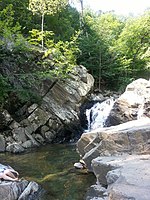David Taylor Model Basin
Art Deco architecture in MarylandBuildings and structures in Bethesda, MarylandGovernment buildings completed in 1938Historic Mechanical Engineering LandmarksInfrastructure completed in 1938 ... and 5 more
Military facilities on the National Register of Historic Places in MarylandNational Register of Historic Places in Montgomery County, MarylandShip designUnited States Navy installationsUse American English from April 2023

The David Taylor Model Basin (DTMB) is one of the largest ship model basins—test facilities for the development of ship design—in the world. DTMB is a field activity of the Carderock Division of the Naval Surface Warfare Center.
Excerpt from the Wikipedia article David Taylor Model Basin (License: CC BY-SA 3.0, Authors, Images).David Taylor Model Basin
Thresher Road,
Geographical coordinates (GPS) Address Nearby Places Show on map
Geographical coordinates (GPS)
| Latitude | Longitude |
|---|---|
| N 38.974166666667 ° | E -77.189444444444 ° |
Address
Thresher Road
20818
Maryland, United States
Open on Google Maps





